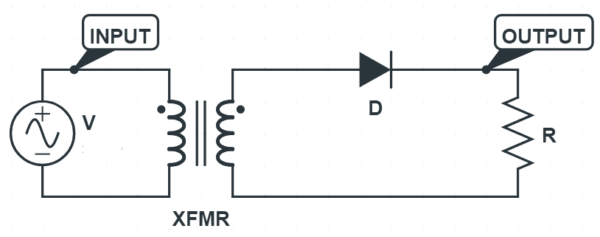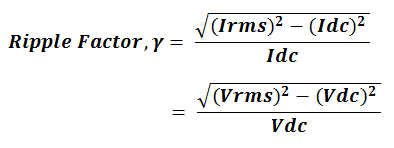The value of ripple factor of single phase half wave rectifier is equal to 1.21. Since, ripple factor is the ratio of RMS value of fluctuating ac component to the average value or dc value. Its value of 1.21 means that, the ac fluctuating component in the rectified output of half wave rectifier is 121% of the expected DC output or average vale. This simply means, the rectification is poor as the ripple content is even higher than the DC output. Let us now see the calculation of this ripple factor.
Calculation of Ripple Factor of Half Wave Rectifier:
The circuit diagram of single phase half wave rectifier is shown below.

The diode will be forward biased for the positive half cycle of the supply whereas it will be reverse biased for the negative half cycle. Thus the diode will conduct only for the positive half cycle and will not conduct for the negative half cycle. Therefore, current output will only be conducting and allowing the current to flow just for the positive half cycle of the supply. This is the reason; it is called single phase half wave rectifier.
The output waveform of half wave rectifier ignoring cut-in voltage is shown in figure below. Blue color depicts the supply voltage whereas red color denotes the rectifier output current.
This output current can be defined as

i = Imsinωt for 0≤ωt≤π
= 0 for π≤ωt≤2π
Let us now find the RMS value and average value of this current to find the ripple factor of half wave rectifier.

Thus, the RMS value of current output of half wave rectifier is 0.5 times of the peak current i.e. 0.5Im.
The average value of single phase half wave rectifier is equal to 0.318 times of peak current i.e. 0.318Im.
Now, the ripple factor of half wave rectifier can easily be calculated from the formula.

Putting the value of RMS current and average current, the value of ripple factor can easily be calculated from the above formula.

Thus, the value of ripple factor of half wave rectifier is 1.21.
Advantages and Disadvantages of Half wave rectifier:
The advantage of a half wave rectifier is only that its cheap, simple and easy to construct. It is cheap because of the low number of components involved. Simple because of the straight forwardness in circuit design. Apart from this, a half wave rectifier has more number of disadvantages than advantages.
Disadvantages
1. The output current in the load contains, in addition to dc component, ac components of basic frequency equal to that of the input voltage frequency. Ripple factor is high and an elaborate filtering is, therefore, required to give steady dc output.
2. The power output and, therefore, rectification efficiency is quite low. This is due to the fact that power is delivered only during one-half cycle of the input alternating voltage.
3. Transformer utilization factor is low.
4. DC saturation of the transformer core resulting in magnetizing current and hysteresis losses and generation of harmonics.
The DC output available from a half-wave rectifier is not satisfactory to make a general power supply. However, it can be used for some applications like battery charging.
No comments:
Post a Comment